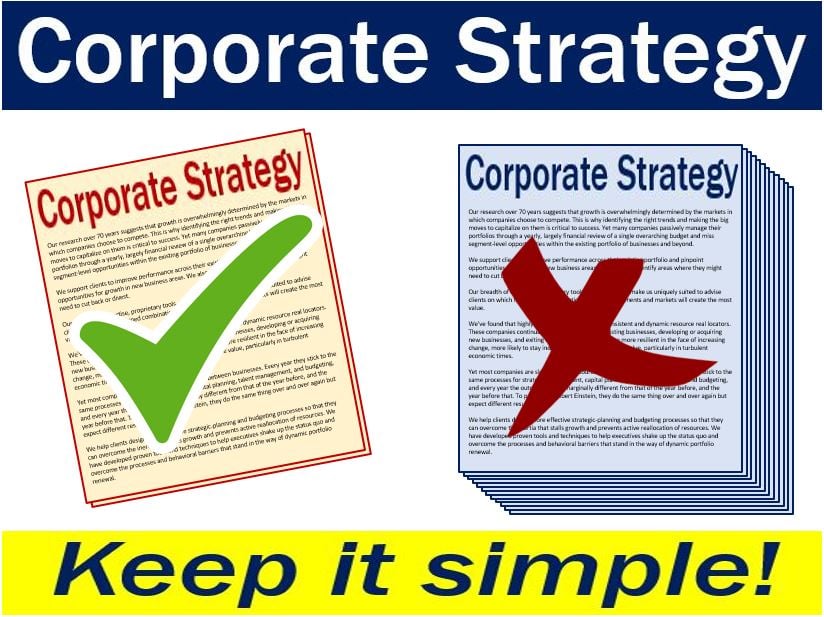Corporate strategy – definition and meaning
We first used the term Corporate Strategy to describe decisions a company should make to reach its goals and create policies to achieve them.
However, many thought this definition was vague because it could apply to any issue that a company faces.
Businesses face several challenges when designing and putting into practice corporate strategies. According to McKinsey & Company, many fail to distinguish corporate strategy from a business strategy.
Corporate strategy – better definition today
There is now, however, a better definition that makes a distinction between business-level and corporate-level strategy.

So, what’s the difference between business-level strategy and corporate-level strategy?
Business-level strategy
According to the University at Albany, business-level strategies:
“Detail actions taken to provide value to customers and gain a competitive advantage by exploiting core competencies in specific, individual product or service markets.”
A business-level strategy is a business objective.
Corporate-level strategy
Michael E. Porter, professor of business administration at the Harvard Business School, stated in his article “From Competitive Advantage to Corporate Strategy” that a corporate-level strategy is the overall plan for a diversified economy.
Put simply; corporate strategy is essentially answering the question:
“How should a company manage a set of businesses together?”
Strategic agility is essential, enabling a corporation to pivot and adapt its strategy in response to market shifts and emerging opportunities.
Harvard professors Davis J. Collis and Cynthia A. Montogomery described corporate strategies as “the way a company creates value through the configuration and coordination of its multi market activities.”

What is corporate strategy about?
Delloite says “corporate strategy is about enabling an organization to achieve and sustain superior performance by overcoming business challenges.” It is also about understanding industry trends and linking tangible actions to a corporation’s vision.
According to the U.K. National Occupational Standards for Management and Leadership, you must be able to do the following:
- Establish a clear, achievable, and compelling vision. Above all, this vision must set out where the organization should be going.
- Identify and prioritize strategic objectives. These objectives should also be consistent with the vision of the organization.
- Balance risk with desired outcomes. In other words, only take risks if the end result is worth it.
- Balance innovation with tried and tested solutions.
- Ensure that your plan is flexible. In other words, your plan should be open to change.
- Develop policies and values that will guide the work of others towards your vision.
- Delegate responsibility for achieving goals. You should also make sure that you allocate resources effectively.
- Identify measures and methods for monitoring the plan. You must also find ways to evaluate it.
- Balance the needs and expectations of key stakeholders. Above all, make sure you win their support.
The sides of the triangle are the foundations of corporate strategy: Resources, Organization, and Businesses.
Ultimately, effective corporate strategy not only aligns with the company’s vision but also dynamically incorporates stakeholder feedback to drive sustainable growth.
Exploring corporate strategy concepts
There are many compound phrases in business English related to corporate strategy. A compound phrase is a term consisting of two or more words. Let’s have a look at some of them:
-
Corporate Strategy Development
The process of defining the direction and scope of a company.
For example: “The CEO emphasized the need for a collaborative approach to corporate strategy development during the annual general meeting.”
-
Corporate Strategy Implementation
The execution of plans and initiatives to achieve a company’s objectives.
For example: “Our corporate strategy implementation phase will begin with the restructuring of key departments.”
-
Corporate Strategy Framework
A structured approach to guide the decision-making process in a business.
For example: “We utilized a robust corporate strategy framework to ensure all investment decisions aligned with our long-term goals.”
-
Corporate Strategy Alignment
Ensuring that all aspects of the company are working towards the same strategic goals.
For example: “The management team is focused on corporate strategy alignment to streamline operations across all branches.”
-
Corporate Strategy Review
A regular evaluation of a company’s strategic plan to ensure it remains relevant and effective.
For example: “The board has scheduled a corporate strategy review for the next quarter to assess progress against our key performance indicators.”
Video – What is Corporate Strategy?
This interesting video, from our sister channel on YouTube – Marketing Business Network, explains what ‘Corporate Strategy’ is using simple and easy-to-understand language and examples.

